Our solar system in the galaxy. Place of the Solar System in the Milky Way Galaxy
“The solar system is part of the Milky Way, a spiral galaxy with a diameter of about 30 thousand parsecs (or 100 thousand light years) and consisting of approximately 200 billion stars. The solar system is located near the plane of symmetry of the galactic disk (20-25 parsecs above, that is, north of it), at a distance of about 8 thousand parsecs (27 thousand light years) from the galactic center (almost equal distance from the center of the Galaxy and its edge), on the outskirts of the Orion Arm - one of the galactic arms of the Milky Way. The angle between the ecliptic plane and the plane of symmetry of the galactic disk is 60º.
The Sun rotates around the galactic center in an almost circular orbit at a speed of about 254 km/s (updated in 2009) and completes a full revolution every 200 million years. This period of time is called the galactic year."("Solar system". Material from Wikipedia - the free encyclopedia ).
Milky Way and our place in it
“What Hubble type is our Galaxy? The fact that it is most likely spiral has been suspected for a long time, but for a long time there were not enough observational facts to prove it. A hundred years ago, the following was known: we live in a gigantic stellar system, numbering hundreds of billions of stars; this system, roughly speaking, has the appearance of an oblate disk with a diameter of about 30 kpc (100 thousand light years). The center of the system is in the constellation Sagittarius.
The Sun is located quite far from the center of the system, but almost exactly in the plane of the galactic equator. The latter circumstance should not make us happy, since it is in the equatorial plane of the Galaxy that dense dust clouds are located. For extragalactic objects, the “zone of avoidance” has long been known, extending 20 degrees on both sides of the galactic equator; other galaxies in this zone are practically not observed.
Not because they are not there, but because dust makes it difficult to see them. The absorption of light in the dust layer of the Galaxy is monstrous, so the “far-sightedness” of the largest optical telescopes near the galactic equator is small. Across the dust layer or at a noticeable angle to it is a different matter.
As a result, we cannot see (in the optical range) the center of the Galaxy. Moreover, we cannot see the spiral arms of the Galaxy - for the same reason that you cannot see the sound track on an old vinyl record if you hold it strictly edge-on. At the end of the famous novel by I.A. Efremov’s “Andromeda Nebula”, earthlings receive from the intelligent inhabitants of the Large Magellanic Cloud a wonderful gift - a snapshot of our Galaxy from the side of the mentioned LMC. And although our Galaxy was taken “from an inconvenient turn,” the value of such a gift is extremely great.
But so far - alas - we know nothing about the existence of extragalactic civilizations, or about their readiness to come into contact with us. Since the plurality of civilizations in the Universe has not been proven at all, it is wiser not to expect gifts from the kind and selfless “Andromedans”, but to look for answers ourselves. They were found mainly using infrared and radio astronomy.
It cannot be said that dust matter is completely transparent to electromagnetic waves in the infrared range, but their absorption in the IR range is much less than in the optical range. Using infrared telescopes, we can see almost right through the galactic disk, study the galactic core, detect extragalactic objects hidden from us by the thickness of the dust disk, etc. However, this brings us little closer to revealing the spiral structure of the Milky Way.
It is more convenient to detect the presence of spiral arms in the radio range. It is known that not only groups of young stars are concentrated in spiral arms, but also the matter that goes into their creation - clouds of gas. For simplicity, we assume that the gas consists exclusively of hydrogen, which, as is known, has an absorption line at a wavelength of 21 cm.
If the gas moves relative to us, then in accordance with the Doppler effect the absorption line will also shift. The radial velocity of each arm relative to us is different, therefore, when observing a distant radio source (for example, a pulsar located somewhere on the edge of the Galaxy), we will receive in its spectrum several hydrogen absorption lines shifted relative to each other, and their number will be equal to the number of spiral arms between radio source and us.
The real picture, of course, is much more complicated, but the principle is clear. We can count the number of spiral arms in the direction of each distant radio source lying near the galactic plane. More precisely, we can only determine how many times the radio emission that came to us crossed the arms, but we cannot say how many spiral arms there are in the Galaxy - after all, a beam can cross a strongly twisted arm twice.
Most spiral galaxies have two arms. The Triangle Nebula (type Sc) has three main ones and a dozen more fragmentary ones. The M63 galaxy, also known as the Sunflower, has dozens.
But how many arms does the Milky Way have? For example, if the spectrum of a distant source has four dips near a wavelength of 21 cm, this could equally mean that the Galaxy has either 4 arms or 2, but longer and more tightly twisted. Or maybe more than four, but less twisted?
Or just one, but wrapped around the core 4 times?
This problem turned out to be, to put it mildly, not an easy one. The key to the solution came from Walter Baade's work on the 100-inch reflector in 1945-1949. Baade found that in the Andromeda Nebula, the spiral arms primarily concentrate hot stars of high luminosity and emission nebulae, as well as dust and superclouds of non-ionized gas.
Now a huge amount of work had to be done to determine the distances to these objects in the Milky Way - extremely difficult, meticulous and error-prone work. In addition, the zone hidden by the galactic core remained (and still remains) inaccessible - it’s not called the “Zona Galactica Incognita” for nothing.
However, astronomers are now drawing the spiral pattern of the Milky Way with a high degree of confidence. It turned out that our Galaxy belongs to the SBb type, has a bar 7-8 kpc long, from each end of which two spiral arms extend (thus, there are four in total) with a twist angle of 10-12 degrees. Galaxy M109 is generally similar to our Galaxy.
It is possible that there is a ring with a diameter equal to the diameter of the bar. Both galaxies have “local arms” - branches from the main spiral arms. The Sun is located in one of these branch arms at a distance of about 8 kpc from the center of the Galaxy.
So, the Milky Way is a large but fairly typical spiral galaxy. As such it must have two types of stellar populations - spherical and flat subsystems(formerly they were called star population types I and II respectively). We have already pointed out above that the bulges of spiral galaxies resemble oblate elliptical galaxies. The bulges consist of stars, mostly old, concentrated towards the center, which also makes them similar to E-galaxies. The bulges are surrounded by vast galactic halos, which are their continuation and also consist of stars..
The halo of the Milky Way extends far beyond its limits - for example, a star belonging to the halo was found, the distance to which is estimated at 400 thousand light years. years. The halo shape is a slightly oblate spheroid. The concentration of stars in it is negligible compared to the bulge and decreases as it approaches the edges of the halo. One can imagine what we would see if the Sun were one of the stars in the halo!
It is unlikely that even one star would decorate our night sky, but the spectacle of the Galaxy stretching across the entire sky would undoubtedly be the most enchanting.
Although, of course, we could not even theoretically be in a halo. After all, the stars that make it up are subdwarfs, born from a gaseous environment poor in heavy elements and obviously do not have terrestrial planets.
The spherical subsystem includes also some variable stars, and most importantly, globular clusters, which do not show a noticeable concentration towards the galactic plane, but are very strongly concentrated towards the center. The Milky Way is surrounded by globular clusters, like a swarm of midges. There are about 150 of them in the Galaxy, but, undoubtedly, not all have been discovered yet. A typical globular cluster is a round or slightly oblate spheroidal formation consisting of old stars (subdwarfs) and differs from elliptical galaxies only in size (from 11 to 590 pc) and the number of stars.
A typical globular cluster contains 100 thousand stars, sometimes several million, whereas a “normal” E-galaxy contains at least billions.
Globular clusters played an important role in the discovery of the rotation of the Galaxy. In 1925, a strange asymmetry was established in the direction of motion of globular clusters: they all move in one direction, and their speeds are very high, at least in comparison with the own speeds of stars close to the Sun - about 200 km/s. A small fraction of stars also have high speeds and shows the same asymmetry of movement. Soon the Swedish astronomer B. Lindblad explained this by saying that two subsystems of the stellar population of the Galaxy - spherical and flat - rotate differently .
And the stars of the galactic disk move just as quickly, revolving around the center of the Galaxy. The Sun makes a full revolution in about 200 million years.
In general, the situation with the rotation of spiral galaxies remained unclear for some time: in which direction do they actually rotate? Do the spiral branches twist during rotation or, conversely, unwind? Domestic considerations (for example, observing water flowing into the bathtub drain) indicated that the branches were most likely twisting, but there was still no complete clarity. At first glance, the solution to the problem was trivial: we need to take a spiral turned towards us at an acute angle and obtain the spectrum of one of its edges - the direction of the Doppler shift will immediately indicate the direction of rotation.
However, not everything is so simple - we don’t know whether the galaxy is facing us “up” or “down”. To solve this question, we had to look for a galaxy in which, firstly, the spiral pattern is clearly visible, and secondly, the equatorial strip of dust matter is no less clearly visible. Only in such a galaxy is it clear where “up” is and where “down” is.
When the desired galaxy was found, the question was resolved: galaxies rotate so that their arms twist, rather than unwind. Common sense, gleaned from near the bathtub drain, prevailed.
However, excuse me: after all, during the existence of the Galaxy (at least 12 billion years, according to any modern estimates), the spiral branches should have spun around the center of the Galaxy several dozen times! And this is not observed either in other galaxies or in ours. In 1964, C. Lin and F. Shu from the USA, developing the ideas of B. Lindblad, came up with a theory according to which spiral arms are not some kind of material formations, but waves of matter density that stand out against the smooth background of the galaxy primarily because in They undergo active star formation, accompanied by the birth of high-luminosity stars.
The rotation of the spiral arm has nothing to do with the movement of stars in galactic orbits. On short distances from the core, the orbital velocities of stars exceed the speed of the arm, and stars flow into it from the inside and leave from the outside. At large distances, the opposite is true: the arm seems to run towards the stars, temporarily includes them in its composition, and then overtakes them.
As for the bright OB stars that determine the pattern of the sleeve, they, having been born in the sleeve, end their short lives in it, simply not having time to leave the sleeve.
Nothing can be said about the reason for the emergence of spiral arms, except that arms (and, under certain initial conditions, bars) always appear in numerical simulations of the birth of a galaxy, if the mass and torque are given sufficiently large. Try to answer the question yourself about the reason for the appearance of slowly rotating spiral waves around the already mentioned drain hole in the bathtub. It’s unlikely that anything will come to mind other than the profound: “Turbulence...” This in itself is true, but processes like turbulence are known so much special branches of mathematics, we do not undertake to describe in understandable terms why it occurs. Let us only note that turbulence is not always chaos.
Quite often it is capable of creating structures like convective cells (remember granules on the surface of the Sun?) or spiral arms of galaxies.
Only in Sa (SBa) type galaxies do we not see arm fragmentation. In the Sb (SBb) and Sc (SBc) galaxies, the arms are fragmented. They are also fragmented in our Galaxy.
The raggedness of the Milky Way, which is essentially the arm closest to us, is striking and is largely explained by the distribution of clouds of interstellar dust near the Sun. Mostly, but not completely! Real stellar clouds are known in which young stars have a genetic connection with each other. For example, at a distance of 1.5 kpc from the Sun in the direction of the constellation Sagittarius there is a compact star cloud about 50 pc in size.
Much larger groups of young stars are also known, sometimes reaching a size of 1 kpc and containing millions of stars. Such groups - their characteristic diameter is about 600 pc - are called stellar complexes.
Stellar complexes are literally strung on spiral arms, like beads on a thread. There is no doubt that they owe their origin to the inflow of a large amount of gas into the spiral arm and the subsequent waves of star formation. The stellar complex contains a large number of open star clusters, born as a result of gravitational compression of small gas-dust clouds compared to the size of the complex and numbering from ten to a thousand stars, several larger stellar associations, as well as one or more stellar aggregates, under which refers to large polycentric associations like the one observed in Orion. Of course, in the same volume of space there are many older stars that do not owe their birth to this complex, but simply travel through it.
One of these stars is well known to us - the Sun.
Back in 1879, the American astronomer Benjamin Gould noticed that bright stars They are not evenly distributed in the sky, but are concentrated into a certain stripe or belt. It would not be surprising if its plane coincided with the plane of the Milky Way, but the fact is that there is an angle of 18 degrees between them. The Gould Belt is a disk-shaped structure (more precisely, a rough oblate spheroid) whose center lies about 150 pc from us, its diameter is estimated at 750 pc, and its age is 30 million years.
This is a typical star complex, one of many, and it includes 60% of the bright stars in our sky. The unit in Orion with a large number of young stars and the famous nebula is also included in it. The Sun, with its orbital speed not much different from the speed of rotation of the spiral arms, will remain within the Gould belt for a long time.
To the question about what all subsystems of the Galaxy rotate around,you can answer just as stupidly, as well as to the question about the origin of the sleeves: around the core. But what is the galactic core in general and the core of our Galaxy in particular?
For a long time, it was only clear that the density of stars in the core is orders of magnitude greater than in the relative wilderness where the Sun is located. If near the Sun the stellar density is approximately 0.1 stars per cubic parsec, then in the core there are several thousand stars per cubic parsec. The inner region of the nucleus is another two to three orders of magnitude denser.
Even direct collisions between stars can occasionally occur in the core. Just imagine the night sky there! The concept of “night” will be very relative due to the absence of darkness - too many of the brightest stars will dot the sky in an unprecedented scattering, and the patterns of the constellations will change quickly, over the life of one generation of hypothetical aborigines...
At the end of the 50s of the last century, a radio source was discovered in the direction of the galactic center, called Sagittarius A. There was every reason to believe that it was located in the core itself. The position of the source was determined to within a tenth of a degree, and Walter Baade began unsuccessful attempts to detect the nucleus in the optical range - first with a 48-inch Schmidt camera with long exposures, then with a 200-inch Palomar reflector. In desperation, Baade argued that the absorption of light in front of the nucleus was 9 or 10 magnitudes.
The reality turned out to be even worse: Later studies revealed a point infrared source at the site of the radio source Sagittarius A, and it turned out that the absorption of light in the optical range is 27 magnitudes! It should be noted that currently astronomers can detect a point source of optical radiation of approximately the 30th magnitude. With extended sources the situation is worse. But even the core would be a point source with a brightness of -2"; galactic dust would still make the core invisible in the optical range.
Detailed studies of the core, in particular tracking the movement of individual stars, are carried out using infrared telescopes.
Strictly speaking, the radio source Sagittarius A consists of two components - western and eastern. The western one is precisely the core of the Galaxy, and the eastern one is simply a young Supernova remnant. Surprisingly, many signs of ongoing star formation have been found within a radius of 100 pc from the galactic center. Although, if we think about it, this should not surprise us. There is still enough gas in the Galaxy (~10% of the substance that can be detected by modern methods).
The collision of gas clouds with each other causes them to lose their angular momentum, causing the gas (or at least part of it) to flow toward the galactic core. The same thing, and even more effectively, happens when gas enters the Galaxy from outside. If you look at the balance of gaseous matter in the Galaxy, it turns out that a mass of gas approximately equal to the solar mass is spent annually on star formation, and at the same time, the Galaxy annually “sucks” from the intergalactic medium, according to various estimates, from 0.2 to 1 solar mass .
On a much larger scale, the appropriation of foreign gas by a Galaxy occurs when another galaxy passes through it and during acts of galactic cannibalism, which will be discussed below. In short, the presence of gas in the core suitable for star formation is quite understandable.
It had long been suspected that there was a supermassive black hole at the center of the core, but only in 2003 was convincing evidence obtained. It was possible to trace the orbits of eight high-luminosity stars located near the galactic center. Their orbital speeds are so high that there is no need to bequeath the continuation of the study of their movements to future generations of astronomers.
One of these stars has an orbital period of only 15 years. In 1999, another star rushed by at a speed of 9 thousand km/s at a distance of only 60 AU. from the central object of the Galaxy. The orbits of all eight traced stars are elliptical, their parameters have been found, which means that the mass of the central object can be calculated using Kepler’s third law. It is about 3 million solar masses.
Such an object cannot be anything other than a black hole.
The black hole at the center of our Galaxy is a rather modest formation in mass for such objects and very quiet compared to the active nuclei of some galaxies. The matter absorbed by the black hole “screams in horror,” converting up to 15% of its mass into radiation. Of course, the electromagnetic “scream”, which also consists of quanta of hard radiation, is stronger the more matter falls into the black hole.
There is no doubt that in the past, when in the center of the still young Galaxy there was much more diffuse matter, its “central monster” behaved much more actively.
But let's return to the galactic periphery. In recent years, the concepts of “dark energy” and “dark matter” have become widely known to the public. This matter is dark not in the sense that it does not transmit radiation, but in the sense that “it is clear that the matter is dark.” It transmits any radiation unhindered, without interacting in any way with it or with matter, except for the only interaction - gravitational.
Is there dark matter in our Galaxy?
Yes, there is, and its mass is at least several times greater than the mass of visible matter. For some time now, astronomers have begun to notice that something incongruous is happening with the rotation of the peripheral parts of spiral galaxies. Near the center, everything is fine with rotation: The bulge of our Galaxy rotates like a rigid body up to a distance of 1 kpc from the center (except for the innermost areas, where the influence of the “central monster” is strong), that is, the speed of orbital motion of stars increases linearly with distance from the center . Further, the rotation velocity line on the graph experiences an inflection and, in theory, should decrease in accordance with Keplerian law as it approaches the edge of the galaxy.
This is understandable: if a certain object, say a star or a cloud of molecular hydrogen, is located near the edge of the galaxy, then gravitational forces should act on this object predominantly in one direction - towards the galactic center, and attraction from the more distant periphery can already be neglected.
However, reality once again presented astronomers with a surprise, and perhaps not a pleasant one. The strict and beautiful formula for the orbital velocities of galactic objects, derived by the remarkable Dutch astronomer J. Oort, suddenly “limped” at large distances from the center . It turned out that the peripheral regions of many spiral galaxies, including ours, rotate at a much higher speed than the Oort formula dictates. We are talking, of course, not about the speed of rotation of the spiral pattern, but about genuine orbital speeds stars, gas clouds and so on. An error was excluded: after all, determining the radial velocity of one or another part of the galaxy, turned edge-on towards us, is as easy as shelling pears from the Doppler shift.
This is more difficult to do for the Milky Way, but it’s also not such a problem.
The only reasonable explanation was this:galaxies - at least spiral ones - are much more massive and extensive than previously thought . The observed part of galaxies is only the “tip of the iceberg”.The real sizes of galaxies are many times larger than their apparent sizes. , And Vast dark matter, which does not manifest itself in any way except gravity, surrounds visible matter, like the pulp of a plum surrounds the pit.
The physical nature of the dark matter is still unclear , although there is no shortage of hypotheses. What, The Universe has once again thrown us a riddle from among those that force us to reconsider previous ideas about the Universe . Not the first time and definitely not the last time.”("The Milky Way and our place in it" ).
Position of the Sun in the Milky Way Galaxy
© Vladimir Kalanov
"Knowledge is power".
Where is the Sun?
In the 50s of the last century, scientists managed to create a picture of the distribution of clouds of ionized hydrogen located in the galactic neighborhood of the Sun. It turned out that there are at least three areas that could be identified with the spiral arms of the Milky Way. Scientists called one of them, the closest to us, the Orion-Cygnus arm. The one more distant from us and, accordingly, closer to the center of the Galaxy is called the Sagittarius-Carinae arm, and the peripheral one is called the Perseus arm.
But the explored galactic neighborhood is limited: interstellar dust absorbs the light of distant stars and hydrogen, so it becomes impossible to understand the further pattern of spiral arms.
The position of the Sun inside the Galaxy was determined by studying nearby Cepheids - variable stars pulsating due to internal physical processes that change their brilliance. Changes in brightness occur with a certain period: the longer the period, the higher the luminosity of the Cepheid, and therefore the energy released by the star per unit time. And from it you can determine the distance to the star. The pioneer here was the American astrophysicist Harlow Shapley. One of the objects of his interest was globular star clusters, so dense that their cores merge into a continuous glow. The area richest in globular clusters is located in the direction of the zodiacal constellation Sagittarius. They are also known in other galaxies, and these clusters are always concentrated near galactic nuclei. If we assume that the laws for the Universe are the same, we can conclude that our Galaxy should be structured in a similar way. Shapley found Cepheids in its globular clusters and measured the distance to them.
It turned out that the Sun is not located in the center of the Milky Way, but on its outskirts, one might say, in a stellar province, at a distance of 25 thousand light years from the center. Thus, for the second time after Copernicus, the idea of our special privileged position in the Universe was debunked. The Sun is located in the plane of our Galaxy and is removed from its center by 8 kpc and from the plane of the Galaxy by approximately 25 pc. In the region of the Galaxy where our Sun is located, the stellar density is 0.12 stars per pc 3 .
The path of the Sun in the Galaxy
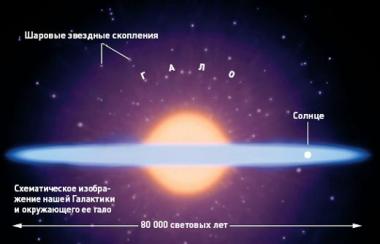
All the stars in the Galaxy, including the Sun, revolve around its core. To complete a full revolution, the Sun requires no less than 250 million years, which constitute a galactic year (the speed of the Sun is 220 km/s). has already flown around the center of the Galaxy 25-30 times. This means that she is exactly that many galactic years old.
Tracing the Sun's path through is very difficult. But modern telescopes can detect this movement too. In particular, to determine how the appearance of the starry sky changes when the Sun moves relative to the nearest stars. The point in the direction of which the Sun is moving at a speed of about 19.5-20 km/s is called the apex and is located in the constellation Hercules, on the border with the constellation Lyra, its coordinates α ≈ 18h, δ ≈ +30°. The flight of the Sun (and at the same time the whole solar system) occurs at approximately an angle of 25 degrees to the plane of the Galaxy. The point on the celestial sphere opposite the apex is called antiapex. At this point the directions of the natural velocities of the stars closest to the Sun intersect.
Every 33 million years, the Sun crosses the galactic equator, then rises above its plane to a height of 230 light years and descends again towards the equator.
It takes, as already mentioned, about 250 million years for the Sun to complete a full revolution. But one should distinguish between the movement of the Sun relative to the center of the Galaxy and the movement of relatively nearby stars. The solar system is surrounded by a local interstellar cloud, warm and dense, which, like all clouds, consists of gas and dust. Moreover, the mass of dust is only 1% of the mass of the entire interstellar cloud. And the gas in it is 90% hydrogen and 9.99% helium. The heavier elements add up to no more than 0.01% by mass. The Sun is located within this cloud in an area sometimes called the local "bubble", which is a large and relatively empty space. By the way, space is so empty that it’s hard to even imagine! Imagine: the best, most “empty” modern laboratory vacuum is 10,000 times denser than ordinary interstellar clouds, (quite visible in photographs taken with telescopes) which are thousands of times denser than the local “bubble”! The density of this “bubble” is only 0.001 atom per cubic centimeter! But its temperature is truly astronomical: about a million degrees Kelvin! In comparison, the local interstellar cloud surrounding the “bubble” is slightly warm, its temperature is 7000 degrees Kelvin. Planet Earth, solar system , and all the stars visible naked eye are situated in Milky Way Galaxy
, which is a barred spiral galaxy that has two distinct arms starting at the ends of the bar. This was confirmed in 2005 by the Lyman Spitzer Space Telescope, which showed that the central bar of our galaxy is larger than previously thought. Spiral galaxies
The spiral arms in such galaxies begin at the ends of the bars, whereas in ordinary spiral galaxies they extend directly from the core. Observations show that about two-thirds of all spiral galaxies are barred. According to existing hypotheses, bridges are centers of star formation that support the birth of stars in their centers. It is assumed that, through orbital resonance, they allow gas from the spiral arms to pass through them. This mechanism provides the influx of building material for the birth of new stars.
The Milky Way, together with the Andromeda galaxy (M31), Triangulum galaxy (M33), and more than 40 smaller satellite galaxies form the Local Group of Galaxies, which, in turn, is part of the Virgo Supercluster. "Using infrared imaging from NASA's Spitzer Telescope, scientists have discovered that the Milky Way's elegant spiral structure has only two dominant arms from the ends of a central bar of stars. Previously, our galaxy was thought to have four main arms." http://s.dreamwidth.org/img/styles/nouveauoleanders/titles_background.png) 0% 50% no-repeat rgb(29, 41, 29);">
Galaxy structure By appearance Planet Earth,, the galaxy resembles a disk (since the bulk of the stars are located in the form of a flat disk) with a diameter of about 30,000 parsecs (100,000 light years, 1 quintillion kilometers) with an estimated average thickness of the disk of the order of 1000 light years, the diameter of the bulge in the center of the disk is 30,000 light years. The disk is immersed in a spherical halo, and around it is a spherical corona. The center of the galactic core is located in the constellation Sagittarius. The thickness of the galactic disk at the location where it is located Planet Earth, with planet Earth is 700 light years. The distance from the Sun to the center of the Galaxy is 8.5 kiloparsecs (2.62.1017 km, or 27,700 light years). located on the inner edge of an arm called the Orion Arm. In the center of the Galaxy, apparently, there is a supermassive(Sagittarius A*) (about 4.3 million solar masses) around which, presumably, revolves a black hole of average mass from 1000 to 10,000 solar masses and an orbital period of about 100 years and several thousand relatively small ones. The galaxy contains, according to the lowest estimate, about 200 billion stars (modern estimates range from 200 to 400 billion). As of January 2009, the mass of the Galaxy is estimated at 3.1012 solar masses, or 6.1042 kg. The bulk of the Galaxy is contained not in stars and interstellar gas, but in a non-luminous halo of dark matter.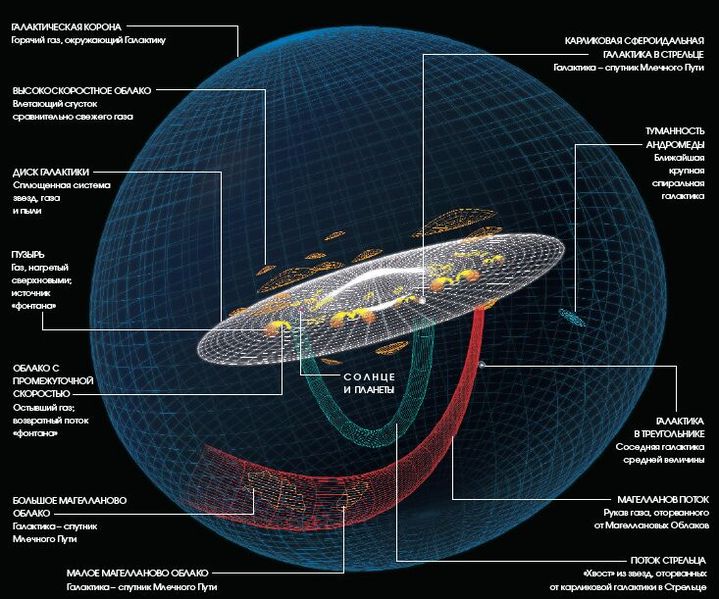
Compared to the halo, the Galaxy's disk rotates noticeably faster. Its rotation speed is not the same different distances from the center. It rapidly increases from zero at the center to 200-240 km/s at a distance of 2 thousand light years from it, then decreases somewhat, increases again to approximately the same value and then remains almost constant. Studying the peculiarities of the rotation of the Galaxy's disk made it possible to estimate its mass; it turned out that it is 150 billion times greater than the mass of the Sun. Age Milky Way galaxies equals13,200 million years old, almost as old as the Universe. The Milky Way is part of the Local Group of galaxies.
http://s.dreamwidth.org/img/styles/nouveauoleanders/titles_background.png) 0% 50% no-repeat rgb(29, 41, 29);"> Solar System Location
Planet Earth, is located on the inner edge of an arm called the Orion Arm, in the outskirts of the Local Supercluster, which is sometimes also called the Virgo Super Cluster. The thickness of the galactic disk (in the place where it is located) Planet Earth, with planet Earth) is 700 light years. The distance from the Sun to the center of the Galaxy is 8.5 kiloparsecs (2.62.1017 km, or 27,700 light years). The sun is located closer to the edge of the disk than to its center.![]()
Together with other stars, the Sun rotates around the center of the Galaxy at a speed of 220-240 km/s, making one revolution in approximately 225-250 million years (which is one galactic year). Thus, during its entire existence, the Earth has flown around the center of the Galaxy no more than 30 times. The galactic year of the Galaxy is 50 million years, the period of revolution of the jumper is 15-18 million years. In the vicinity of the Sun, it is possible to trace sections of two spiral arms that are approximately 3 thousand light years away from us. Based on the constellations where these areas are observed, they were given the name Sagittarius Arm and Perseus Arm. The sun is located almost in the middle between these spiral branches. But relatively close to us (by galactic standards), in the constellation Orion, there passes another, not very clearly defined arm - the Orion Arm, which is considered a branch of one of the main spiral arms of the Galaxy. The speed of the Sun's rotation around the center of the Galaxy almost coincides with the speed of the compaction wave that forms the spiral arm. This situation is atypical for the Galaxy as a whole: the spiral arms rotate with a constant angular velocity , like spokes in wheels, and the movement of stars occurs with a different pattern, so almost the entire stellar population of the disk either falls inside the spiral arms or falls out of them. The only place where the velocities of stars and spiral arms coincide is the so-called corotation circle, and it is on it that the Sun is located. For the Earth, this circumstance is extremely important, since violent processes occur in the spiral arms, generating powerful radiation that is destructive for all living things. And no atmosphere could protect from it. But our planet exists in a relatively calm place in the Galaxy and has not been affected by these cosmic cataclysms for hundreds of millions (or even billions) of years. Perhaps this is why life was able to be born and preserved on Earth, the age of which is estimated at 4.6 billion years. A diagram of the location of the Earth in the Universe in a series of eight maps that show, from left to right, starting with the Earth, moving insolar system, , to neighboring star systems, to the Milky Way, to local Galactic groups, to
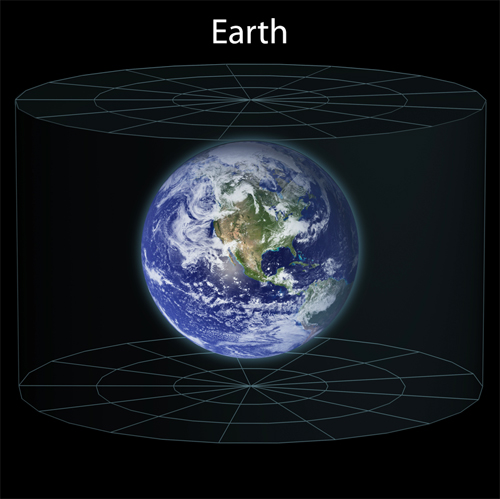
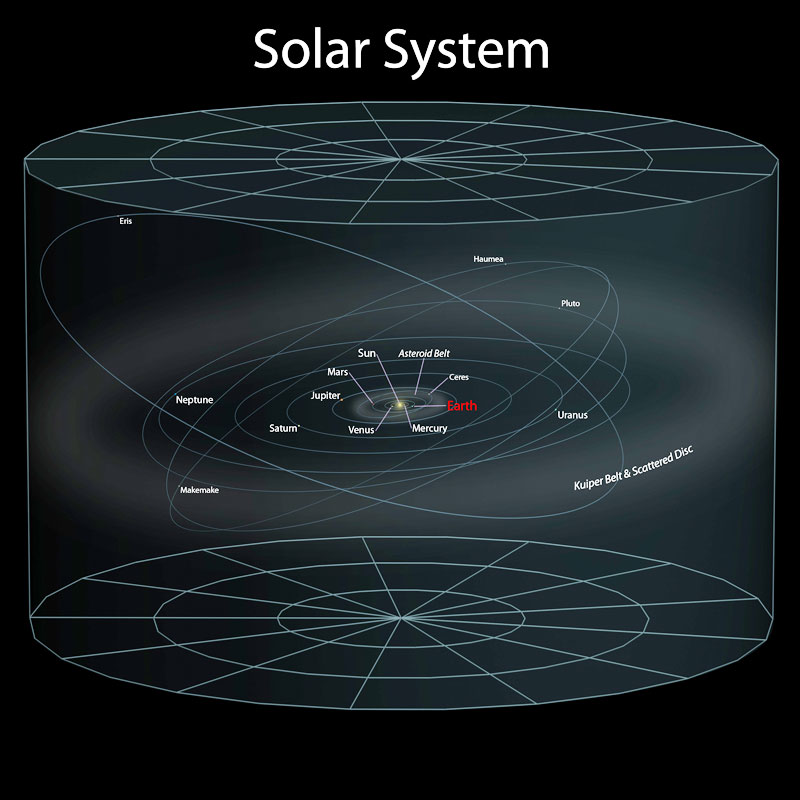
local Virgo superclusters
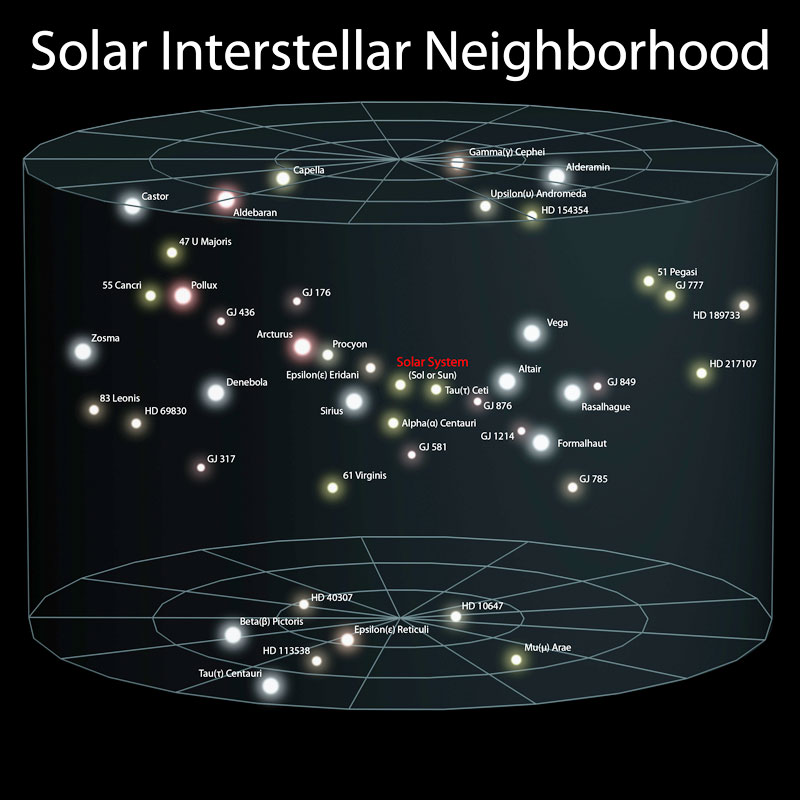
on our local supercluster, and ends in the observable Universe.
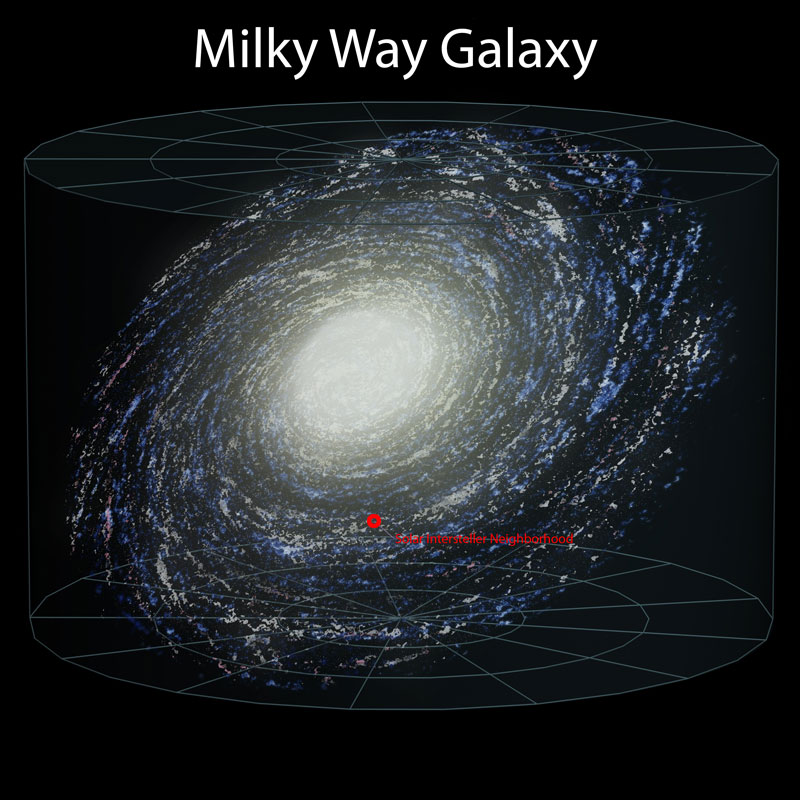
Solar System: 0.001 light years
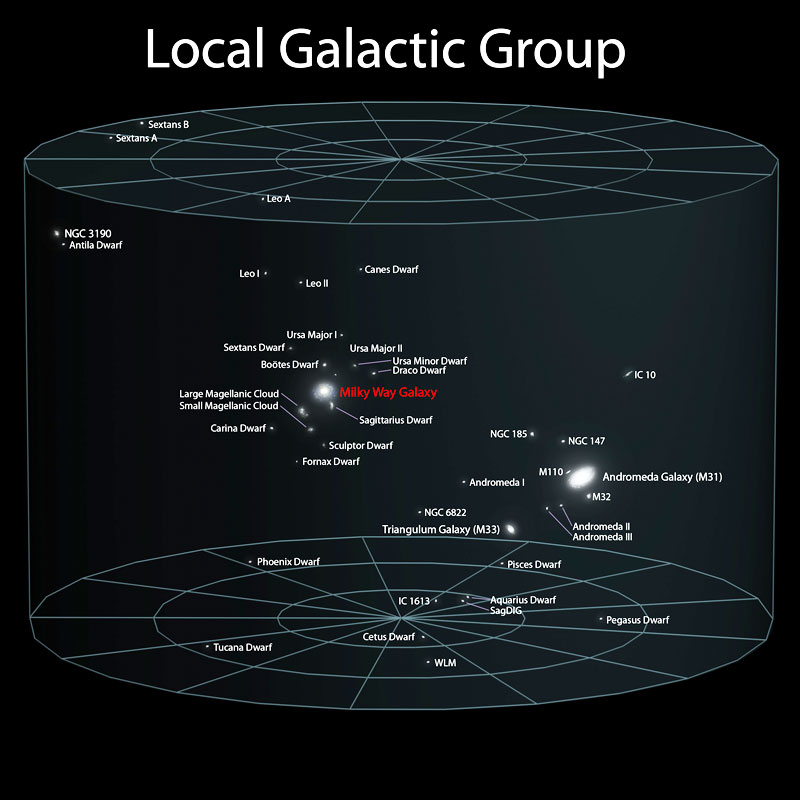
Neighbors in interstellar space
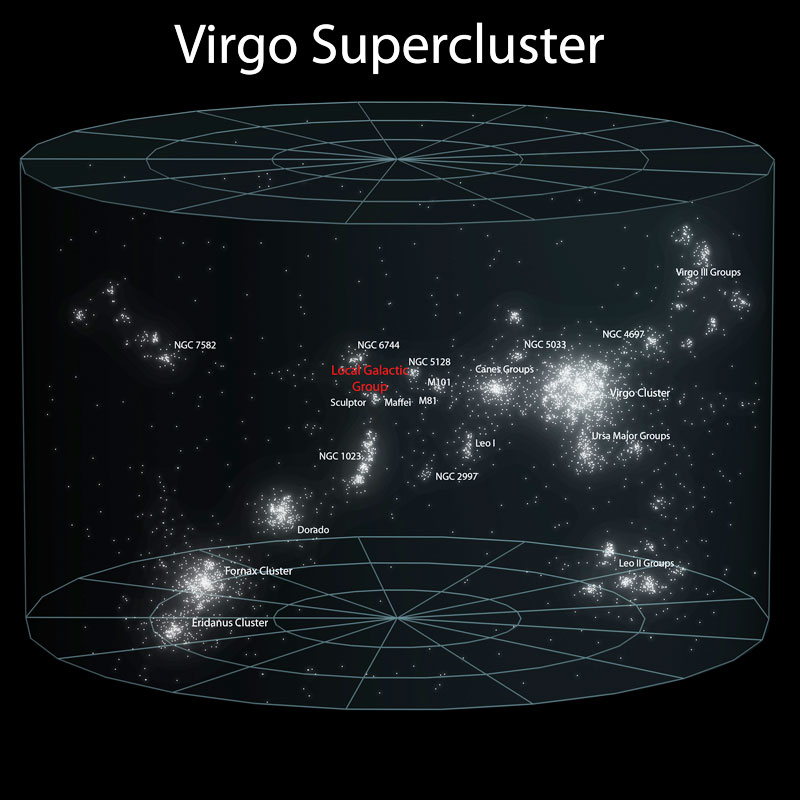
Milky Way: 100,000 light years
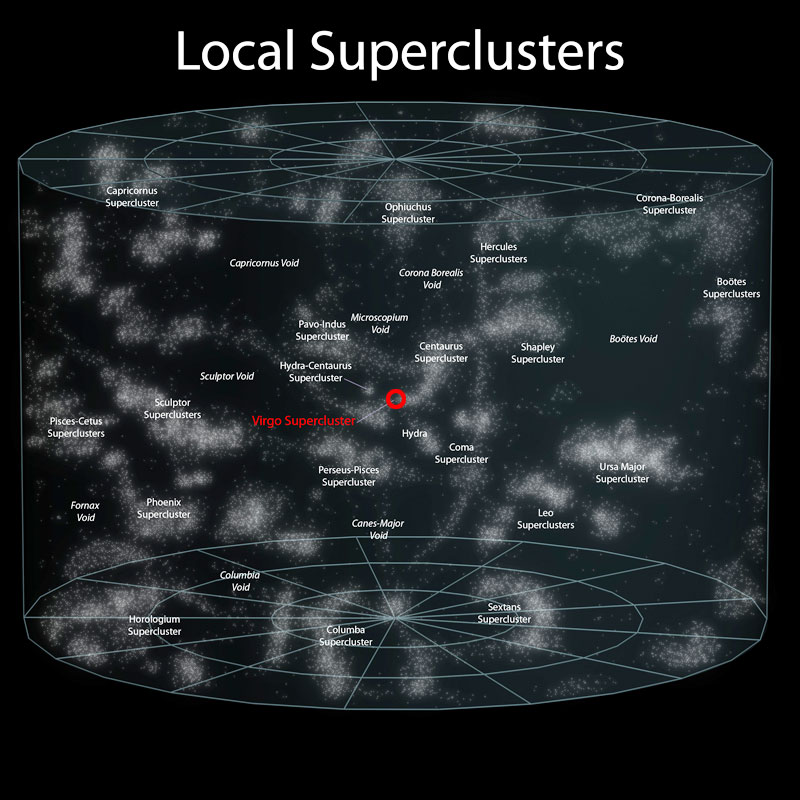
Local Galactic Groups above a galaxy cluster
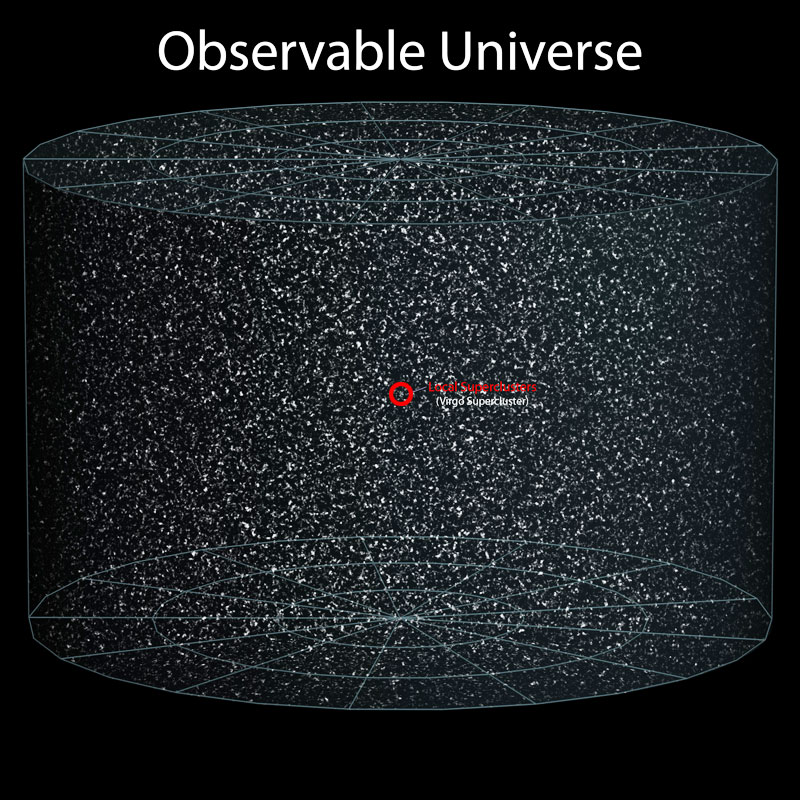
Observable Universe
Our Galaxy and the place of the Sun in itIn the 17th century, after the invention of the telescope, scientists first realized how large the number of stars is in outer space. In 1755, German philosopher and naturalist Immanuel Kant proposed that stars form groups in the cosmos, just as the planets form the solar system. He called these groups “star islands.” According to Kant, one of these countless islands is the Milky Way - a grandiose cluster of stars, visible in the sky as a light, foggy stripe. In ancient Greek, the word “galaktikos” means “milky”, “milky”, which is why the Milky Way and similar star systems are called galaxies.
Kant's assumption was confirmed by the method of star counts, which was first used at the end of the 18th century. English astronomer William Herschel. The essence of this method is to compare the number of stars falling into the same areas at different distances from the plane of the Milky Way. Such calculations were carried out repeatedly and led to the following main results: firstly, the number of stars decreases sharply with distance from the Milky Way; secondly, the total number of stars south of the plane of the Milky Way is slightly greater than the number of stars north of it. Thus, it was established that the dimensions of our stellar system in the direction of the Milky Way significantly exceed its dimensions in the perpendicular direction, and the Sun is located slightly above the plane of symmetry of this system.
Dimensions and structure of our Galaxy
Based on the results of his calculations, Herschel attempted to determine the size of the Galaxy. He concluded that our star system has finite dimensions and forms a kind of thick disk: in the plane of the Milky Way it extends to a distance of no more than 850 units, and in the perpendicular direction - to 200 units, if we take the distance to Sirius as one. In the modern distance scale this corresponds to 7300x1700 light years.
This estimate generally correctly reflects the structure of the Milky Way, although it is highly imprecise. The fact is that in addition to stars, the Galaxy’s disk also includes numerous gas and dust clouds that weaken the light of distant stars.
The true size of the Galaxy was established only in the 20th century.
It turned out that it is a much flatter formation than previously thought. The diameter of the galactic disk exceeds 100 thousand light years, and the thickness is about 1000 light years.
In appearance, the Galaxy resembles a lentil grain with a thickening in the middle.
Due to the fact that the Solar System is located practically in the plane of the Galaxy, filled with absorbing matter, many details of the structure of the Milky Way are hidden from the view of an earthly observer. However, they can be studied using the example of other galaxies similar to ours. So, in the 40s. this century, observing the M 31 galaxy, better known as the Andromeda nebula, the German astronomer Walter Baade (in those years he worked in the USA) noticed that the flat lens-shaped disk of this huge galaxy is immersed in a more rarefied spherical star cloud - a halo. Knowing that the Andromeda nebula is very similar to our Galaxy, Baade suggested that the Milky Way also has a similar structure. Stars in the galactic disk were called population type I, and stars in the halo (or spherical component) were called population type II.
As modern research shows, the two types of stellar populations differ not only in their spatial position, but also in the nature of their motion and chemical composition. These features are associated primarily with the different origin of the disk and the spherical component.
Halo
The boundaries of our Galaxy are determined by the size of the halo. The radius of the halo is significantly larger than the size of the disk and, according to some data, reaches several hundred thousand light years. The center of symmetry of the Milky Way halo coincides with the center of the galactic disk. The halo consists mainly of very old, dim, low-mass stars.
They occur individually and in globular clusters that can contain more than a million stars. The age of the population of the spherical component of the Galaxy exceeds 10 billion years. It is usually taken to be the age of the Galaxy itself.
Stars and halo star clusters move around the center of the Galaxy in very elongated orbits. Due to the fact that the rotation of individual stars occurs almost randomly (i.e., the speed neighboring stars can have very different directions), the halo itself generally rotates very slowly.
Disk
Compared to a halo, the disk rotates noticeably faster. The speed of its rotation is not the same at different distances from the center. It quickly increases from zero at the center to 200-240 km/s at a distance of 2 thousand light years from it, then decreases somewhat, increases again to approximately the same value and then remains almost constant. Studying the characteristics of the disk's rotation made it possible to estimate its mass. It turned out that it is about 150 billion times the mass of the Sun.
The disk population is very different from the halo population. Young stars and star clusters, whose age does not exceed several billion years, are concentrated near the plane of the disk. They form the so-called flat component. There are a lot of bright and hot stars among them.
The gas in the Galaxy's disk is also concentrated mainly near its plane. It is distributed unevenly, forming numerous gas clouds - from giant “superclouds” with a heterogeneous structure several thousand light years long to small clouds no larger than a parsec in size.
The main chemical element in our Galaxy is hydrogen.
Approximately 1/4 of it consists of helium. Compared to these two elements, the others are present only in very small quantities. On average, the chemical composition of the stars and gas in the disk is almost the same as that of the Sun.
Core
One of the most interesting regions of the Galaxy is considered to be its center, or core, located in the direction of the constellation Sagittarius.
In addition to a large number of stars, a circumnuclear gas disk consisting predominantly of molecular hydrogen is observed in the central region of the Galaxy. Its radius exceeds 1000 light years. Closer to the center, areas of ionized hydrogen and numerous sources of infrared radiation are noted, indicating star formation. In the very center of the Galaxy, the existence of a massive compact object is assumed - a black hole with a mass of about a million solar masses. At the center of the Galaxy there is also a bright radio source, Sagittarius A, the origin of which is associated with the activity of the nucleus.
Spiral branches
One of the most noticeable formations in the disks of galaxies like ours are spiral arms (or arms). They gave the name to this type of objects - spiral galaxies. The spiral structure in our Galaxy is very well developed. Along the arms are mainly concentrated the youngest stars, many open star clusters and associations, as well as chains of dense clouds of interstellar gas in which stars continue to form. The spiral arms contain a large number of variable and flare stars, and explosions of some types of supernovae are most often observed in them. Unlike a halo, where any manifestations of stellar activity are extremely rare, vigorous life continues in the branches, associated with the continuous transition of matter from interstellar space to stars and back. The galactic magnetic field, which permeates the entire gaseous disk, is also concentrated mainly in spiral formations.
The spiral arms of the Milky Way are largely hidden from us by absorbing matter. Their detailed study began after the advent of radio telescopes. They made it possible to study the structure of the Galaxy by observing the radio emission of interstellar hydrogen atoms concentrated along the long spiral arms. According to modern concepts, spiral arms are associated with compression waves propagating across the galactic disk. Passing through regions of compression, the matter of the disk becomes denser, and the formation of stars from gas becomes more intense.
The reasons for the appearance of such a unique wave structure in the disks of spiral galaxies are being clarified.
In the vicinity of the Sun, it is possible to trace sections of two spiral branches located approximately 3 thousand light years away from us. Based on the constellations where these areas are found, they are called the Sagittarius arm and the Perseus arm. The sun is almost halfway between these spiral arms. True, relatively close (by galactic standards) to us, in the constellation Orion, passes another one, a less pronounced branch, considered a branch of one of the main spiral arms of the Galaxy.
The distance from the Sun to the center of the Galaxy is 23-28 thousand light years, or 7-9 thousand parsecs.
This suggests that the Sun is located closer to the outskirts of the disk than to its center.
Together with all nearby stars, the Sun rotates around the center of the Galaxy at a speed of 220-240 km/s, making one revolution in approximately 200 million years. This means that during its entire existence the Earth has flown around the center of the Galaxy no more than 30 times.
The speed of rotation of the Sun around the center of the Galaxy practically coincides with the speed with which the compaction wave, forming the spiral arm, moves in this region. This situation is generally unusual for the Galaxy: the spiral branches rotate at a constant angular velocity, like the spokes of a wheel, and the motion of stars, as we have seen, obeys a completely different pattern. Therefore, almost the entire stellar population of the disk either falls inside the spiral branch or leaves it. The only place where the velocities of stars and spiral arms coincide is the so-called corotation circle, and it is on it that the Sun is located!
This circumstance is extremely favorable for the Earth. Indeed, violent processes occur in the spiral branches, generating powerful radiation that is destructive for all living things. And no atmosphere could protect from it. But our planet exists in a relatively calm place in the Galaxy and for hundreds of millions and billions of years has not experienced the influence of these cosmic cataclysms. Perhaps this is why life could originate and survive on Earth.
